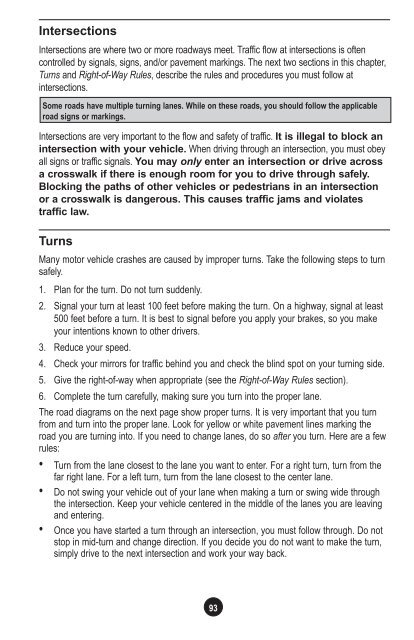Drivers_Manual
Drivers_Manual
Drivers_Manual
You also want an ePaper? Increase the reach of your titles
YUMPU automatically turns print PDFs into web optimized ePapers that Google loves.
Intersections<br />
Intersections are where two or more roadways meet. Traffic flow at intersections is often<br />
controlled by signals, signs, and/or pavement markings. The next two sections in this chapter,<br />
Turns and Right-of-Way Rules, describe the rules and procedures you must follow at<br />
intersections.<br />
Some roads have multiple turning lanes. While on these roads, you should follow the applicable<br />
road signs or markings.<br />
Intersections are very important to the flow and safety of traffic. It is illegal to block an<br />
intersection with your vehicle. When driving through an intersection, you must obey<br />
all signs or traffic signals. You may only enter an intersection or drive across<br />
a crosswalk if there is enough room for you to drive through safely.<br />
Blocking the paths of other vehicles or pedestrians in an intersection<br />
or a crosswalk is dangerous. This causes traffic jams and violates<br />
traffic law.<br />
Turns<br />
Many motor vehicle crashes are caused by improper turns. Take the following steps to turn<br />
safely.<br />
1. Plan for the turn. Do not turn suddenly.<br />
2. Signal your turn at least 100 feet before making the turn. On a highway, signal at least<br />
500 feet before a turn. It is best to signal before you apply your brakes, so you make<br />
your intentions known to other drivers.<br />
3. Reduce your speed.<br />
4. Check your mirrors for traffic behind you and check the blind spot on your turning side.<br />
5. Give the right-of-way when appropriate (see the Right-of-Way Rules section).<br />
6. Complete the turn carefully, making sure you turn into the proper lane.<br />
The road diagrams on the next page show proper turns. It is very important that you turn<br />
from and turn into the proper lane. Look for yellow or white pavement lines marking the<br />
road you are turning into. If you need to change lanes, do so after you turn. Here are a few<br />
rules:<br />
• Turn from the lane closest to the lane you want to enter. For a right turn, turn from the<br />
far right lane. For a left turn, turn from the lane closest to the center lane.<br />
• Do not swing your vehicle out of your lane when making a turn or swing wide through<br />
the intersection. Keep your vehicle centered in the middle of the lanes you are leaving<br />
and entering.<br />
• Once you have started a turn through an intersection, you must follow through. Do not<br />
stop in mid-turn and change direction. If you decide you do not want to make the turn,<br />
simply drive to the next intersection and work your way back.<br />
93


